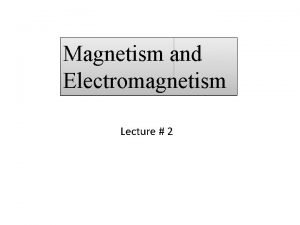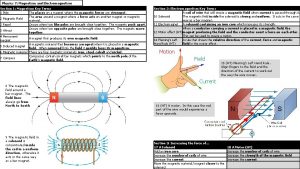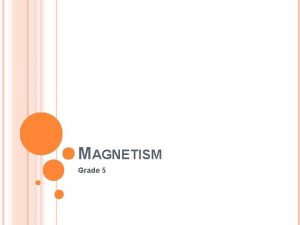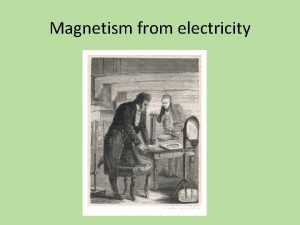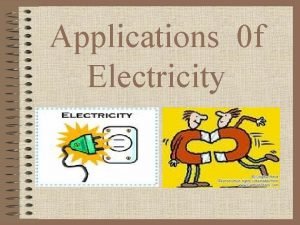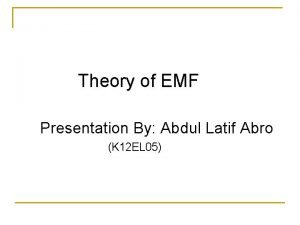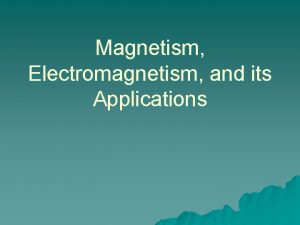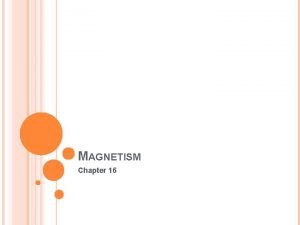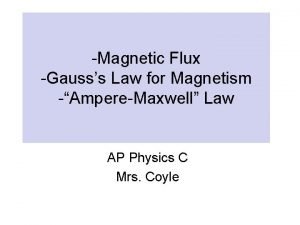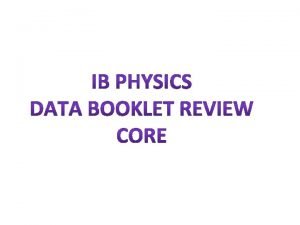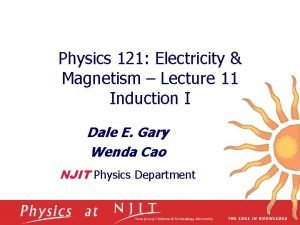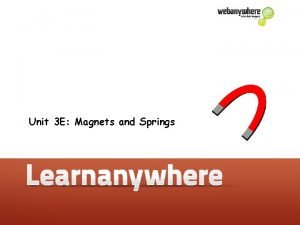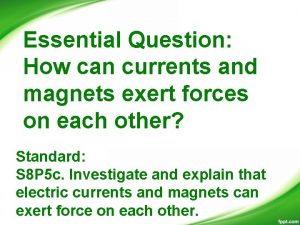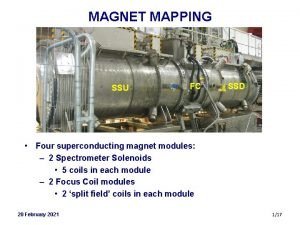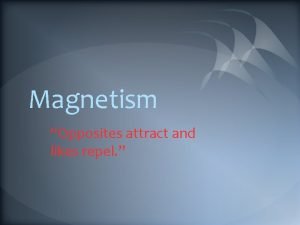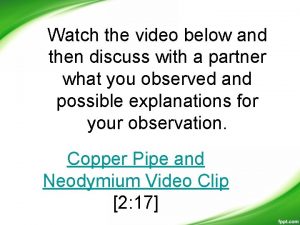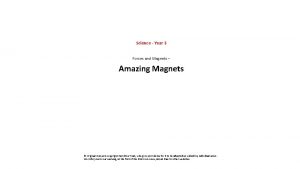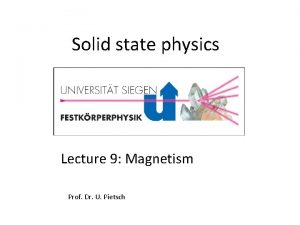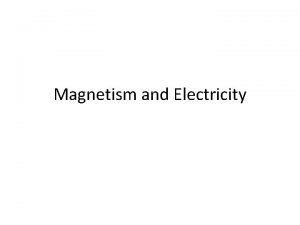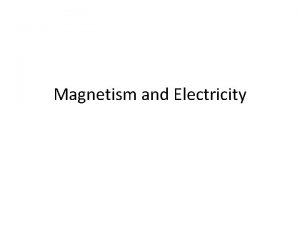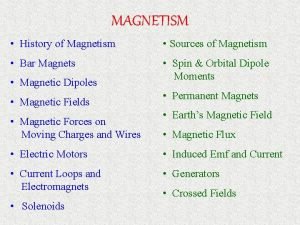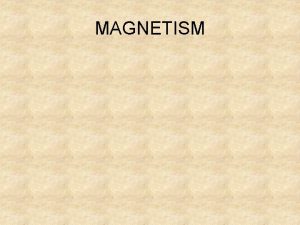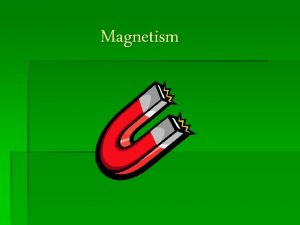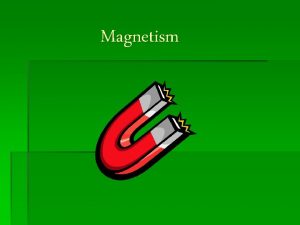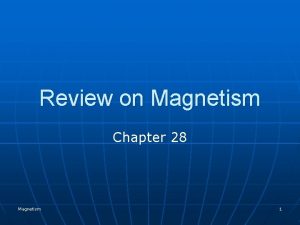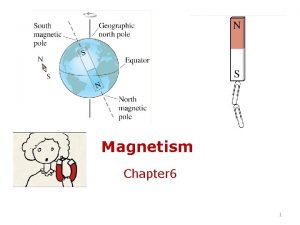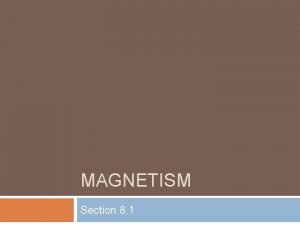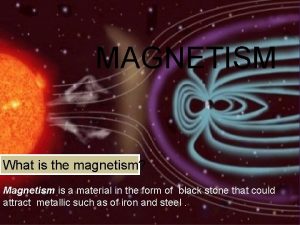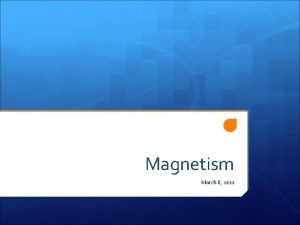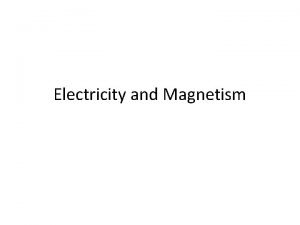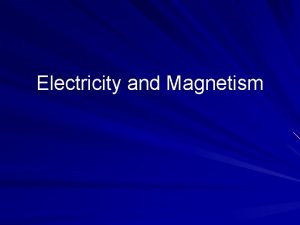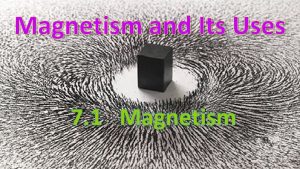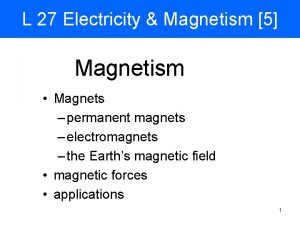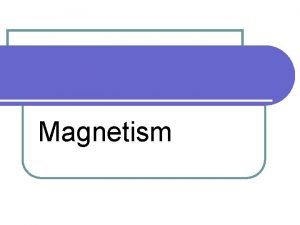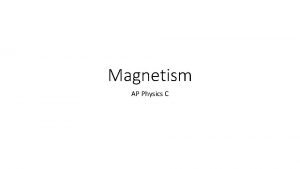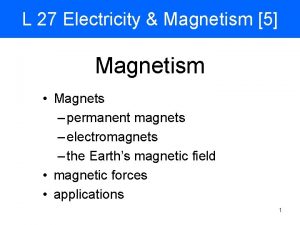Magnets and Magnetism History First magnets were lodestones
































- Slides: 32

Magnets and Magnetism ► History § First magnets were lodestones – rock with iron ore § Found in Magnesia, Greece about 2000 years ago § Chinese used for navigation in 12 th century ► Possible (common) shapes: bar, horseshoe, disk, flat, really anything ► Poles § all have 2, a North & South pole § likes repel, opposites attract § can’t be isolated - no “magnetic monopole” ever found - because of the very nature from which all magnetism originates. . .

► Spinning Cause of Magnetism e-’s… a single spinning e- is the tiniest magnet, complete with a N & S pole ► In most substances, e-’s come in pairs that spin in opposite directions, so they cancel each other’s magnetic effect ► If e-’s spin in same direction, then magnetic affect is apparent § Called ferromagnetic materials, after iron or ferrum in Latin § Fe has 4 unpaired e-’s that can all be made to spin the same way… Co has 3… Ni has 2… Al has 1… § But most have none, so no chance of being magnetic.

Magnetic Domains ► In materials with multiple e-’s spinning the same way, neighboring atoms pair up to form large groups of atoms whose spins are aligned – called domains. ► 1 domain ≈ 1015 atoms ► If the domains are aligned, then you’ve got a magnet; not aligned – just plain metal: aligned - so a magnet:

► Uses of Magnetic Domains § Credit/debit cards § VHS & cassette tapes § 3. 5” floppy disks for computers § security tags on clothing, electronics

► 1. § § § Types of Magnets Permanent Made of strong ferromagnetic materials - those whose domains are easy to align and stay aligned ►Ferrite – mixed with ceramics, like iron oxides or plastics – flat magnets 5 m. T ►Alnico – mostly iron, then aluminum, nickel, cobalt ►Rare earth – ex: neodymium 1. 25 T Not exactly “permanent” – can jostle the domains out of alignment ►dropping it or banging it ► heating it to Curie temperature (768 C for Fe) ►place near strong but opposite magnetic field Can be re-magnetized using an electromagnet

► 2. Temporary § Made of weak ferromagnetic materials – those whose domains only stay aligned in the presences of a magnetic field ►Nails and a construction hammer ►Paperclips in a kitchen junk drawer with fridge magnets ►Even steel food cans in pantry – what’s the magnetic field nearby? ? Around the wiring in the walls of a house… a perfect lead into the 3 rd type of magnet!

Magnetic Fields ►


Earth’s Magnetic Field ► As if a bar magnet stretches along the rotational axis… ► but not exactly: the difference between “true north” and magnetic north is called magnetic declination – 0 to 20 difference in USA ► And it wanders… up to 15 km in a year ► Strength: BEarth≈ 5 x 10 -5 T, ► Angle of dip: angle between field & horizontal surface of Earth

► Probable Earth’s Magnetic Field cause is motion of molten iron in Earth’s core ► Not constant!: it’s changed more than 1000 x’s in our 5 million year history and creates long periods where it’s zero then it reverses and grows – its weakening now ► The lines represent magnetic field lines, blue when the field points towards the center and yellow when away. The dense clusters of lines are within the Earth's core. [

Earth’s Magnetic Field ► On a magnet like in a compass, N indicates the pole that attracts to geographic North pole, which is actually the Earth’s magnetic South pole… otherwise they wouldn’t be attracted… (provable by using RHR on an electromagnet… more to come…) ► So BE points to magnetic S, as all B’s do, but that matches Earth’s geographic North. (Fyi: This can be confusing when determining directions in upcoming math problems. )

Uses of Earth’s Magnetic Field Compass ► Homing pigeons – records of more than 1000 miles, but typically less than 100 mi. For mail, messages during war. ► Migratory birds – NY Times article 4/26/12 ► Salmon – use smell to find river where they spawned, but magnetism to make their way in ocean currents ► Monarch butterflies – a generation flies South – as many as 3000 miles in the early Fall! They winter in Mexico then head North in Spring. It takes 3 to 4 generations to make it all the way North by end of Summer, then that generation heads South again – crazy! ►

Uses of Earth’s Magnetic Field ► The magnetosphere is the region above the ionosphere that is defined by the extent of the Earth's magnetic field in space. § It extends several tens of thousands of kilometers into space. § Protects the Earth from the charged particles of the solar wind and cosmic rays that would otherwise strip away the upper atmosphere, including the ozone layer, that protects the Earth from harmful ultraviolet radiation.

Uses of Earth’s Magnetic Field ► Creates the Auroras § When charged particles from the sun run into Earth’s magnetic field, they transfer their energy. § More likely to happen/be seen where field is strongest, so near the poles: aurora borealis (northern lights); aurora australis (southern lights) § The colors of the lights are determined by the concentration and ionization levels of primarily oxygen and nitrogen. Greens are more common than blues and reds.

3. Electromagnets ► A magnetic field is created around moving charges… current ► Discovered by Hans Christan Oersted in 1820 ► To make it stronger § Use more current § Wrap more loops of wire § Add solid ferromagnetic core ► Uses § scrap metal yards § MRI machines – very strong, 3 -10 T § Our re-magnetizer

So the 1 st connection between E and M? An electromagnet! Here’s how we figured to use it: If you supply a potential difference across a wire, so that a current flows, a magnetic field is then created around the wire. Then place it in another magnetic field, the 2 magnetic fields interact with (apply forces to) each other, making the wire begin to move !!!

And then, to make use of that motion: If the wire is formed into a loop then current flows in both directions within the magnetic field so different sides of the loop will feel a force in opposite directions (torque…more to come later…) making the coil of wire spin – that’s a motor! Now, attach “whatever” to it: • Fan blades • Blender blades • Hair dryer • Lawn mower blades • Drive shaft axel wheels of car

Basic components of a motor A very basic motor

► Eq’n: FB Math of E&M (20. 4) = l. I x B § finds (Laplace) force FB, on a wire of length l, carrying current I, in a uniform magnetic field B § I x B is cross product of 2 vectors, so FB = l IBsin , where is the angle between I & B’s tails. § So 0 force if I & B are parallel; max F if perpendicular § Units: newtons = meter amp tesla ► Eq’n: FB = qv x B § finds (Lorentz) force FB on a charge q, moving at v in a uniform magnetic field B – if not moving, then no F! § v x B is cross product of 2 vectors, so FB = qv. Bsin , where is the angle between v & B’s tails. § Units: newtons = coulomb (meter/sec) tesla § where a coulomb/sec = amps… so same as above. ► Eq’ns find magnitude (no sign on q!); RHRs find directions

Right Hand Rules for E&M (20. 3) 1 st RHR: deals with only two vector quantities: I & B. ► If the wire is straight, § point thumb in direction of current, I and your fingers will curl in the direction of (north) magnetic field, B. § So answer will be CW or CCW, § unless a particular location is specified. ► If the wire is looped, § Run thumb along the loop in direction of I, and fingers will curl around loop to show B… § but if want B’s direction in a particular location around the loop, must stop finger tips from wrapping at that location. OR § curl the fingers in the direction of I, and your thumb will show direction of B inside the loop.

Right Hand Rules for E&M (20. 3) 2 nd RHR: deals with 3 vectors: I (or v of q), B & F. § index finger points in direction of I or positive q, § middle/rest of fingers point in direction of B § thumb points in direction of F. Note, use LHR if q is negative! Also, you can choose to use your left hand for I and +q’s out of convenience, but then all your answers will be opposite what you’re hand tells you!!

► Note new notation: to indicate a vector in 3 D – into/out of page: use ☉ for up/out of page, like you’re seeing the arrow tip come at you. And for down/into page, like you’re looking at the arrow’s tail going away from you. So this would look like Here’s what a 3 D directional key will look like: Let’s learn how to use this on P 1 & 3 from homework…

Cool & Practical Result of RHR: ► If a charged particle is moving perpendicular to a uniform magnetic field, its path will be a circle! § Using ΣFC = ma. C § then FB = mv 2/r § and qv. B = mv 2/r

Magnetic Field Due to a Long Straight Wire (20. 5) Circumference of the circle B makes around the wire. Notice the field is directly proportional to current in wire, and inversely proportional to the distance from the wire. Recall: Variable Name μm Magnetic permeability (think “permeate”) Electric permittivity (think “permit”) Value for Vacuum (free space) Relationship B μm *

Force between Two Parallel Wires (20. 6) The magnetic field produced at position of wire 2 due to the current in wire 1 is: If perpendicular, the force this field exerts on a length l 2 of wire 2 is: since FB = l I x B and sin 90 = 1 Where due to RHR, parallel currents attract; antiparallel currents repel.

Solenoids and Electromagnets (20. 7) A solenoid is a long coil of wire. If it is tightly wrapped, the magnetic field in its interior is almost uniform, so it essentially creates a bar magnet with a field strength of: If a piece of iron is inserted in the solenoid, the magnetic field strength is magnified. Such electromagnets have many practical applications: • Door bells • Car starters • GFCIs

More on Magnetic Fields 2 ways to express the Intensity of a Magnetic Field ► Magnetic field strength, H § Corresponds to the density of the field lines, § created by magnet or current carrying wire. § Units of amperes per meter (A/m). ► Magnetic flux density, B § The effect of magnetic field strength on a given material. For example… ► a solenoid produces magnetic field strength H, which only depends on amount of current & # of loops. ► Whereas flux density varies by the material used inside the hollow solenoid, ► so if ferromagnetic material used, flux is high; if not, flux is low, ► using eq’n B = μm. H, where μm is determined by nature of the core material (permeability of material, instead of free space).

► (More) Units for magnetic flux density § cgs: gauss (G) = 10 -4 T § mks: tesla (T) = N/A m Also T = J/A m 2 = N/C m/s = kg/C s = kg/A s 2 ► Recall, the units for E are N/C (from E = F/q) whereas units for B are N/C m/s (from B = F/qv) which again emphasizes difference between E & B: E is not dependent on q’s motion, but B is! Other examples of magnetic strength: ► 8 T – magnets in LHC (Large Hadron Collider in Cern) ► 16 T – required to levitate a frog (via diamagnetic levitation of the water in its body tissues) according to the 2000 Ig Nobel Prize in Physics (parody of real ones: ) ► 27 T – maximum field strengths of super conducting magnets at cryogenic temperatures ► 108 - 1011 T – magnetic strength of the average magnetar!!

Ampère’s Law: B is produced by I (20. 8)

Torque on Current Loop; Magnetic Moment (20. 9)

Applications of Torque on Current Carrying Loops (20. 10) A galvanometer’s loop is turned by torque which increases as I increases. An electric motor changes electrical energy to mechanical energy. Speakers convert electrical signals into mechanical vibrations, producing sound.

Another Application: Mass Spectrometer (20. 11) A mass spectrometer measures the masses of atoms. If a charged particle is moving through perpendicular electric and magnetic fields, there is a particular speed at which it will not be deflected: All the atoms reaching the second magnetic field will have the same speed, which means their radius of curvature will depend on their mass.
 Was/were going to and was/were supposed to
Was/were going to and was/were supposed to Physics 102
Physics 102 Ib physics topic 5 question bank
Ib physics topic 5 question bank Magnetism
Magnetism A substance that attracts pieces iron
A substance that attracts pieces iron Magnetism jeopardy
Magnetism jeopardy Sph3u electricity and magnetism
Sph3u electricity and magnetism Magnetism and electromagnetism
Magnetism and electromagnetism Electromagnet experiment hypothesis
Electromagnet experiment hypothesis Induced magnetic moment
Induced magnetic moment Grade 5 electricity and magnetism
Grade 5 electricity and magnetism Electricity and magnetism
Electricity and magnetism Magnetic field of two magnets
Magnetic field of two magnets Electricity and magnetism
Electricity and magnetism Electricity and magnetism
Electricity and magnetism Abro orientation
Abro orientation Electromagnetism vs magnetism
Electromagnetism vs magnetism What is magnet
What is magnet Gauss law in magnetism
Gauss law in magnetism Electricity and magnetism
Electricity and magnetism Electricity and magnetism
Electricity and magnetism Magnetism vocabulary
Magnetism vocabulary Magnets and springs
Magnets and springs Properties and interactions of magnets
Properties and interactions of magnets Magnets and magnetic fields lesson 1 answer key
Magnets and magnetic fields lesson 1 answer key Explain how currents and magnets exert forces on each other
Explain how currents and magnets exert forces on each other Ssd magnet
Ssd magnet With magnets likes repel and opposites
With magnets likes repel and opposites Currents and magnets summarizer
Currents and magnets summarizer Attract repel
Attract repel Currents and magnets summarizer
Currents and magnets summarizer Magnetism love
Magnetism love Magnetism
Magnetism




